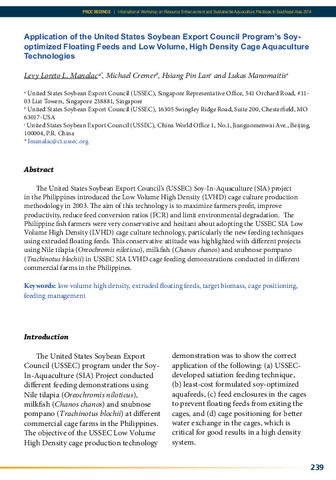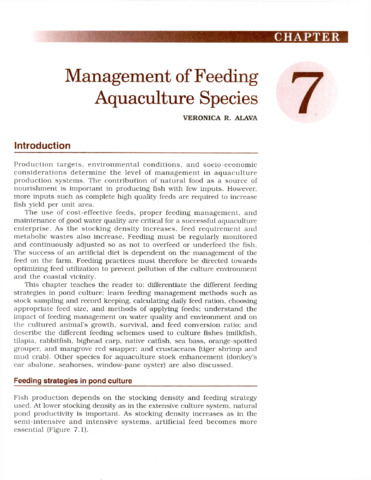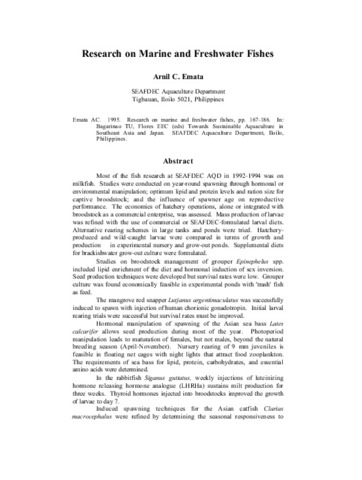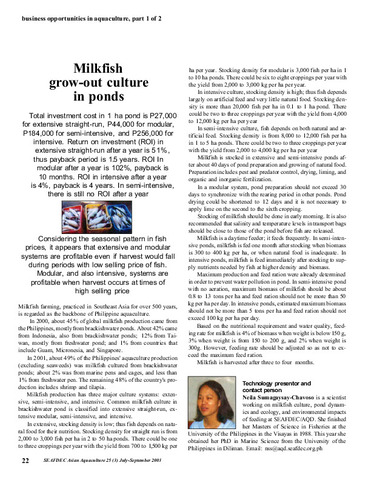Application of the United States Soybean Export Council program's soy-optimized floating feeds and low volume, high density cage aquaculture technologies
Share
Abstract
The United States Soybean Export Council s (USSEC) Soy-In-Aquaculture (SIA) project in the Philippines introduced the Low Volume High Density (LVHD) cage culture production methodology in 2003. The aim of this technology is to maximize farmers profit, improve productivity, reduce feed conversion ratios (FCR) and limit environmental degradation. The Philippine fish farmers were very conservative and hesitant about adopting the USSEC SIA Low Volume High Density (LVHD) cage culture technology, particularly the new feeding techniques using extruded floating feeds. This conservative attitude was highlighted with different projects using Nile tilapia (Oreochromis niloticus), milkfish (Chanos chanos) and snubnose pompano (Trachinotus blochii) in USSEC SIA LVHD cage feeding demonstrations conducted in different commercial farms in the Philippines.
Suggested Citation
Manalac, L. L. L., Cremer, M., Lan, H. P., & Manomaitis, L. (2015). Application of the United States Soybean Export Council program's soy-optimized floating feeds and low volume, high density cage aquaculture technologies. In M. R. R. Romana-Eguia, F. D. Parado-Estepa, N. D. Salayo, &M. J. H. Lebata-Ramos (Eds.), Resource Enhancement and Sustainable Aquaculture Practices in Southeast Asia: Challenges in Responsible Production of Aquatic Species: Proceedings of the International Workshop on Resource Enhancement and Sustainable Aquaculture Practices in Southeast Asia 2014 (RESA) (pp. 239-241). Tigbauan, Iloilo, Philippines: Aquaculture Department, Southeast Asian Fisheries Development Center.
Subject
Taxonomic term
Related items
Showing items related by title, author, creator and subject.
-
Management of feeding aquaculture species
Alava, Veronica R. (Aquaculture Department, Southeast Asian Fisheries Development Center, 2002)This chapter teaches the reader to: differentiate the different feeding strategies in pond culture; learn feeding management methods such as stock sampling and record keeping, calculating daily feed ration, choosing ... -
Research on marine and freshwater fishes
Emata, Arnil C. (Aquaculture Department, Southeast Asian Fisheries Development Center, 1995)Most of the fish research at SEAFDEC AQD in 1992-1994 was on milkfish. Studies were conducted on year-round spawning through hormonal or environmental manipulation; optimum lipid and protein levels and ration size for ... -
Milkfish grow-out culture in ponds
Sumagaysay-Chavoso, Neila (Aquaculture Department, Southeast Asian Fisheries Development Center, 2003)Milkfish farming is regarded as the backbone of Philippine aquaculture. In 2001, nearly 50% of the Philippines' aquaculture production was milkfish cultured from brackishwater ponds. It has 3 major culture systems: extensive; ...






